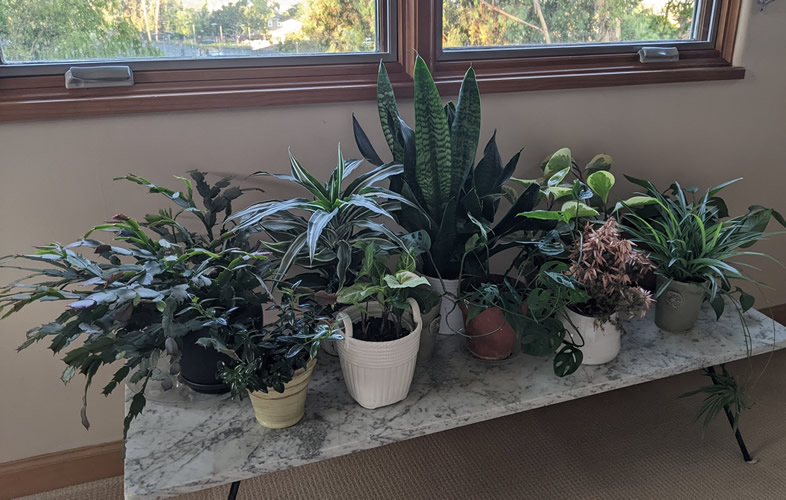House Plant Care
 House Plant Care September
House Plant Care September
We all love our house plants. They are beautiful, fill gaps in our home, provide more oxygen to the environment, and give us visual and emotional pleasure….that Is until they fall apart, wilt, develop pests, and turn the wrong color.
Let’s bring attention to the common problems that plague houseplants and see what it takes to make them thrive.
All plants need air, light and water. What makes a houseplant different than an outside plant is that it grows in your house, in your air and light, and they thrive based on the care that you are willing to provide. With the following knowledge, you will be able to choose the right house plant and give it the proper care to make it flourish.
Watering: The most common cause of houseplant death is overwatering as it suffocates the roots and displaces the oxygen that your plant needs to thrive. While all plant-care books talk about underwatering as well, overwatering is more often the cause of plant failure. If your plant looks funky, what have you done in the past? You probably watered it. And since overwatering is so often the cause of plant death, you have likely now dealt the lethal dose. For most houseplants, you should allow the upper inch of soil to dry out. (There are exceptions, like succulents, orchids and carnivorous plants but we’ll focus on ordinary house plants.) You can usually use ordinary tap water. Because our water has so many salts, it is important to occasionally flush the plant thoroughly in the sink or tub to expel the salts. Do not allow your plants to sit in water. Besides drowning the roots, it invites mosquitos to lay their eggs in the water causing a mosquito infestation. If you want to increase the humidity, group your plants together. Some plants can sit in a tray with a bit of water below a layer of pebbles. Be sure to let the water completely evaporate before adding more water in the tray. Occasional misting is also a nice way to add humidity.
If you are willing to check your plants frequently and water when needed, buy the variety of plants that you love. I buy plants that will do well with being watered weekly. Mine will even survive a two-week vacation without water.
Fertilizing: Like us, your plants will do better with proper nutrition. There are specialty fertilizers made for specific houseplants like African Violets. All-purpose fertilizers (liquids, pellets, spikes, granules, and sprays) work just as well. Buy what you want and follow all directions. Because most plants grow more slowly in the winter months, you can fertilize less frequently. Some experts even recommend using fertilizers at half strength.
Temperature: Most houseplants come from tropical areas so they like temperatures between 65’ and 80’. Avoid drafts and proximity to vents, heaters, and air conditioners. Some, but not all, houseplants will thrive on a porch or covered patio. So much depends on your location and which direction your area faces. A plant may do beautifully on a shady patio in the coastal areas but die a rapid death in the heat/cold of East County.
Light: This may be the most important factor in choosing your house plants as they can be very picky in their light requirements. Some will grow beautifully in low light while others will die quickly without a lot of light. Houseplants can be classified according to their need for low, medium or high light. Also consider the intensity of the light: east, south, west, or north exposure and double-paned windows or in front of an open window. If your plant is thriving, don’t change its location. If it is not happy, move it to higher or lower light, depending on the plant’s recommendations.
Soil: Soil is another important factor. A good soil allows the best environment for the roots, fertilizer, air, and water to allow your plant thrive. Use a good potting soil. Never ever use dirt from your garden. Some hobbyists prefer to lighten, i.e., aerate, the commercial potting soils with vermiculite or perlite, available at garden centers.
Problems: Many houseplant problems are preventable with good plant care. Other times the problem is so severe that wrapping the plant in a sealed plastic bag and disposing it is the best solution. The most common insects are mealybugs, aphids, fungus gnats, scale, whiteflies, and thrips. And then there are mites, fungi, and mildew. Please see the IPM link at the end of this article for more details on the description and treatment of each of these problems.
The $24,000 dollar question: What houseplant to choose: There are many lists, books, and specialty plant groups out there to tempt you into buying an entire array of beautiful plants. After reading this article you can decide whether to take on the easiest plants (a great short list here https://marinmg.ucanr.edu/PLANTS/HOUSEPLANTS_550) or something to challenge you. Check out this list by the University of Maryland https://extension.umd.edu/resource/selecting-indoor-plants. Talk to a specialist at your local garden center now that you have identified your home environment and what commitment you are willing to make.
Just remember that the plant is the boss. Your job is to match your home and your plant’s needs. And because plants can give so much back in the form of beauty and increased well-being, it is typically worth your effort.
A great website but not .edu https://savvygardening.com/light-for-house-plants/
Houseplant IPM. https://ipm.ucanr.edu/PMG/PESTNOTES/pn74172.html
Houseplant lists https://cagardenweb.ucanr.edu/Houseplants/
Marin MG article https://marinmg.ucanr.edu/CARE/PLANTCARE/Houseplants/
Stewart has been a UCCE Master Gardener since 2012 and is a member of its speaker’s bureau, where she loves sharing her knowledge with the public. She has been a docent at San Diego Botanic Garden since 2008.

